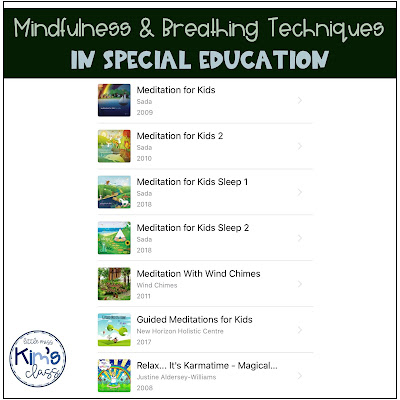Teaching my students to meditate and breathing techniques is one of my greatest joys! Meditation and breathing can provide students with amazing regulation skills and the ability to calm their bodies and minds in a variety of tough situations. A friend and old colleague (who is PE teacher and mindfulness teacher) opened my eyes to teaching meditation and mindfulness practice to students. Many of these ideas are from her and I adapted them for students with disabilities/ special needs.
How we do it & our process:
-How we started:It's important to know that this was process and we had to build up to doing 7 minute meditations!
We started by teaching students a breath a day using the below Breathe With Me book. The book has super fun, simple and engaging breaths. We also practiced taking big belly breaths with breathing balls! It's super simple- breathe in while you're opening the ball, pause and then breath out while you close the ball again. When we first started, our students struggled with short meditations.
We taught students the breaths during circle time, during break time, or any time that it was appropriate/ natural. We made sure to teach students the breaths when they were regulated and then would reinforce using the breaths when they were dysregulated. Then we were able to encourage students to take a breath if they were mad, upset, frustrated, etc. We would say something like, "If you're feeling mad, you can try a bunny breath. Let's do one together!" and then we would model the bunny breath.
You can find the Breathe With Me book on Amazon here.
-Music & Guided Meditations:
After a month or two of just doing breathing techniques, we started doing short guided meditations. We started with the shortest meditations we could find, which were about 3 minutes, but now our students can do 5-7 minute long meditations! We would either have students sit or lay down on a specific spot on the carpet for the meditation or have students sit at their table/ desk spot.
Prior to starting the guided meditation, teachers walk around and will spray room spray in student's areas if they give the teacher a "thumbs up" to indicate that they want a spray (obviously make sure there aren't any allergies are parents are okay with this!). During the guided meditation, teachers walk around the classroom provide shoulder/ back squeezes or pressure (similar to in a yoga class). Teachers quietly whisper to students, "Yes or no?" so every student has the ability to tell the teacher if he/she wants the shoulder/ back squeezes or pressure.
If you have Apple music, below are my favorite Albums for short and kid-friendly guided meditations.
When we do it:
-We work on our mindfulness and breathing during a variety of times of the day:
We also do mindfulness and breathing activities for 3-7 minutes right before a few of the most stressful or chaotic transitions of the day for our students: before lunch and recess, before inclusion times, and before dismissal. We also do them before we have any schedule or routine changes.
-We have a 30 minute gross motor/ exercise time in our schedule and we typically do a mindfulness/ breathing activity for the last 5-10 minutes of the exercise group.
-If students seem anxious or upset, we will ask them if they want to do a meditation or take a breath with us.
How it's changed my students' lives:
-My students have gained the ability to regulate their emotions more effectively and independently!
-Many of my students have learned to use the breaths to ease their nerves during stressful situations and generalized the skill even at home and outside of the classroom!
I've had numerous people ask me what I do with students who refuse to participate and if I have alternative activities for students who don't want to participate. Here's what we do:
-For students who refuse to participate: We let them refuse to participate. We can't MAKE students do anything. However, we do our best to make participating rewarding to encourage students to want to participate. We do this by using the spray, a breathing ball and providing positive reinforcement to students who participate (stamps/ stickers on charts, edibles for certain students, etc.).
-Alternative activities for students who refuse to participate: A regular choice for our students if they refuse to participate in what is on the schedule is independent work. So if students refuse to do meditation, we will say, "Do you want to do meditation or independent work?"
If you haven't tried mindfulness or breathing in your classroom yet, I encourage you to try it! The impact it can have on your students and staff is magical!
Some of our other favorite materials for mindfulness:
-Breathe like a Bear by Kira Willey. This is one of our FAVORITE breathing books! It has 30 different breaths to target different things (calmness, attention, energy, etc.)
-Bunny Breaths, by Kira Willey. This book is great but very different than the Breathe like a Bear and Breathe with Me books. This is a story instead of multiple breathing techniques, but is so fun!
-Listen like an Elephant by Kira Willey. This is also a fun story book!
Note: This post has affiliate links. I personally purchased all of these toys for my classroom and my students love them! I was not given the toys nor am I paid by the toy companies for promoting them. I simply get a few cents from Amazon if you purchase them through my links.







